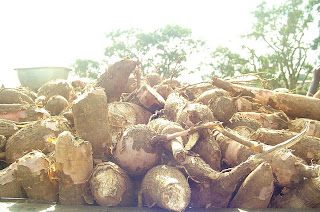Tapioca Cultivation
Cassava Cultivation
The other names........ Kappa, Marachini
 Tapioca is a shrubby, tropical, perennial plant that is not well known in the temperate zone. For most people, Tapioca is most commonly associated with tapioca. The plant grows tall, sometimes reaching 15 feet, with leaves varying in shape and size. The edible parts are the tuberous root and leaves. The tuber (root) is somewhat dark brown in color and grows up to 2 feet long.
Tapioca is a shrubby, tropical, perennial plant that is not well known in the temperate zone. For most people, Tapioca is most commonly associated with tapioca. The plant grows tall, sometimes reaching 15 feet, with leaves varying in shape and size. The edible parts are the tuberous root and leaves. The tuber (root) is somewhat dark brown in color and grows up to 2 feet long.Tapioca thrives better in poor soils than any other major food plant. As a result, fertilization is rarely necessary. However, yields can be increased by planting cuttings on well drained soil with adequate organic matter. Tapioca is a heat-loving plant that requires a minimum temperature of 80 degrees F to grow. Since many cultivars are drought resistant, Tapioca can survive even during the dry season when the soil moisture is low, but humidity is high.

Around the world, Tapioca is a vital staple for about 500 million people. Tapioca's starchy roots produce more food energy per unit of land than any other staple crop. Its leaves, commonly eaten as a vegetable in parts of Asia and


PREPARATION OF THE LAND
When Tapioca is grown as the first crop in forest land. no further preparation is required than the clearing of the forest growth. When Tapioca is grown after other crops. it often can be planted without further preparation of the soil, once the preceding crop has been harvested or the soil has been ploughed two or three times until free from grass and other plants.
 Clearing of forest land is done to let in more sunlight to the ground and to remove weeds and undergrowth which might otherwise compete with economic plants. The practice in tropical southeast Asia is to clear the forest soil completely, including the removal of all roots and other obstructions beneath the soil, by cutting and burning the forest cover; the land is then deeply ploughed. African practice is to burn the land cover only. Burning removes only small branches and under bush but does not consume all of the trunks and branches. It also destroys soil parasites, and the layer of ashes increases the amount of potassium salts available to the growing plants. However, some reports have indicated that complete clearing of the soil in certain parts of
Clearing of forest land is done to let in more sunlight to the ground and to remove weeds and undergrowth which might otherwise compete with economic plants. The practice in tropical southeast Asia is to clear the forest soil completely, including the removal of all roots and other obstructions beneath the soil, by cutting and burning the forest cover; the land is then deeply ploughed. African practice is to burn the land cover only. Burning removes only small branches and under bush but does not consume all of the trunks and branches. It also destroys soil parasites, and the layer of ashes increases the amount of potassium salts available to the growing plants. However, some reports have indicated that complete clearing of the soil in certain parts of 
Cultivation of Tapioca
Tapioca culture varies with the purposes for which it is grown.
Tapioca is either planted as a single crop or intercropped with maize, legumes, vegetables, rubber, oil palm or other plants. Mixed planting reduces the danger of loss caused by unfavorable weather and pests by spreading the risk over plants with different susceptibilities.
For agricultural purposes, Tapioca is propagated exclusively from cuttings. It is raised from seed only for the purpose of selection Seeds produce plants with fewer and smaller roots than those of the parents and as many as half of the seeds may fail to germinate. On the other hand, cuttings taken from the stalks of the plant take root rapidly and easily, producing plants identical in character with the parent plants.
Around the world, Tapioca is a vital staple for about 500 million people. Tapioca's starchy roots produce more food energy per unit of land than any other staple crop. Its leaves, commonly eaten as a vegetable in parts of Asia and Africa , provide vitamins and protein. Nutritionally, the Tapioca is comparable to potatoes, except that it has twice the fiber content and a higher level of potassium.










Casino - Blackjack - JT Hub
ReplyDeleteJTG, LAS 문경 출장샵 VEGAS (KHXT) - Use the JTG 안양 출장안마 mobile 양주 출장마사지 app at JTG, LAS VEGAS and other casinos in LAS VEGAS. 정읍 출장안마 casino; 이천 출장안마 casino; jTG;